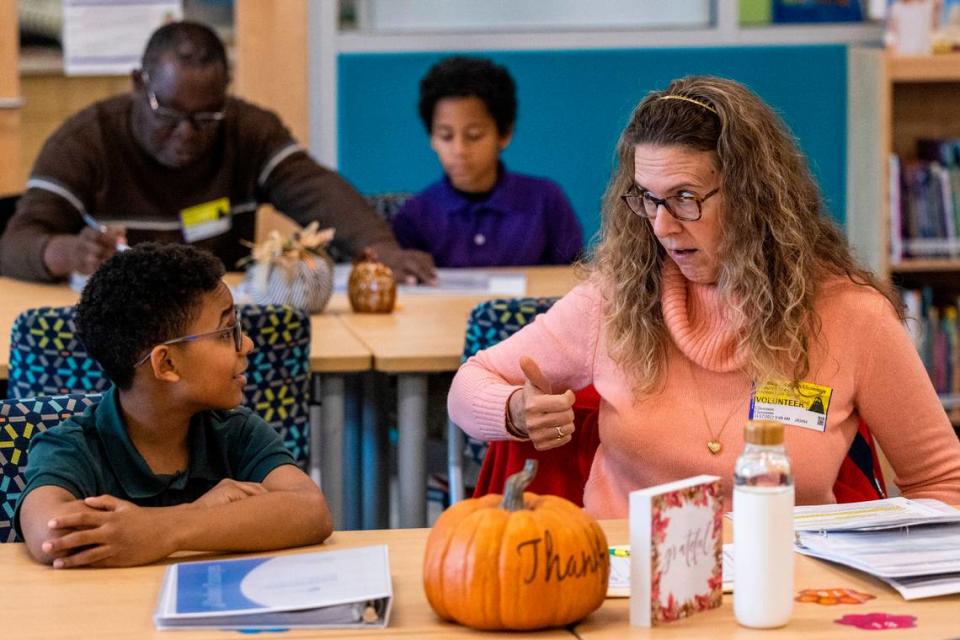New program is helping Wake students learn to read. But it needs more tutors.
More volunteer tutors are needed for a reading program that’s showing success at helping struggling Wake County elementary school students.
The Wake County school system and the WakeEd Partnership are recruiting tutors for the WakeTogether program, which provides intensive reading help to elementary school students. Data shows that the students who were served last school year in the debut of the WakeTogether program saw large gains in their reading fluency skills.
“It is really exciting to see we’re making progress and making a difference and that it’s accessible to many,” Michele Woodson, Wake’s assistant superintendent for student support services, said at a school board committee meeting earlier this month. “It’s an opportunity where kids can really find some success.”
The need for tutors is great. Student achievement rates are rising again in Wake and statewide but largely remain below pre-pandemic levels.
Tutors receive reading fluency training
WakeTogether uses literacy strategies — such as focusing on phonics — from the Raleigh-based HELPS Education Fund.
Students in grades two through five who need reading help receive one to two hours a week of what’s called “high-dosage tutoring.” Volunteer tutors provide one-on-one tutoring while school employees provide small-group tutoring.
Volunteers are asked to commit to at least one hour a week for a semester. Volunteers work with individual students in 20- to 30-minute blocks following a script developed by HELPS.
“You don’t have to be a literacy expert,” Woodson said at the Dec. 6 meeting of the school board’s student achievement committee. “You can work with this program based on how to help a student read fluently. We give them the training and coaching support for that.”
Program closing achievement gaps
The program served 1,058 elementary school students last school year. Some students received either the one-on-one tutoring or the small-group tutoring. Other students received both.

The program primarily served Black and Hispanic students.
By the end of last school year, 31.8% of the program’s students met end-of-year benchmarks for the number of words read correctly. That’s lower than the 68.5% overall district rate for second through fifth grades.
But to put it in perspective, only 2.7% of the HELPS students had met benchmarks at the beginning of the school year compared to 65.6% of students districtwide. The increase for the students in the tutoring program was significantly higher than the district’s growth.
Large gains were seen in the Black and Hispanic students in the WakeTogether program. For instance, the percentage of the Black students in the program who met benchmarks for the number of words read correctly rose from 2.2% at the start of the school year to 43.2% by the end of the school year.
”We are closing gaps in fluency in the number of words read, and remember that’s Black and Hispanic students primarily,” Becky Foote, Wake’s senior administrator for the Title I program, told the committee. “We know how to close those gaps, and when we used evidence-based programs and we have dedicated staff who make this a priority, this is how we can close achievement gaps.”
Students get their ‘a-ha moment’
Staff at Smith Elementary School in Garner shared with the school board how it’s helping at a human level.
“It allowed students in our neediest subgroups to experience success,” Lindsey Machesky, Smith’s intervention team facilitator, told the committee.
Machesky cited the case of a Hispanic female student she called “Jane” who repeated fifth grade last school year. After a year in the tutoring program, Machesky said, Jane’s reading skills and confidence about going to middle school had soared.
After the “moving up” ceremony at the end of the school year, Machesky said Jane told her that “I’m ready this time. I’m excited.”
School board member Cheryl Caulfield said she saw similar excitement at her son’s elementary school after it began using the program.
“You just see these kids’ faces light up when they’re like they got their a-ha moment and they figure it out and they get excited to read,” Caulfield told her colleagues
The school district plans to celebrate the program’s accomplishments at an upcoming school board meeting.
“I hope this can be a success story that we can use to recruit other volunteers,” said school board member Tyler Swanson.
How to volunteer
Go to wakeed.org/waketogether to learn how to become a volunteer tutor in the WakeTogeher reading literacy program. Volunteers will need to complete a background check and receive training before starting.

